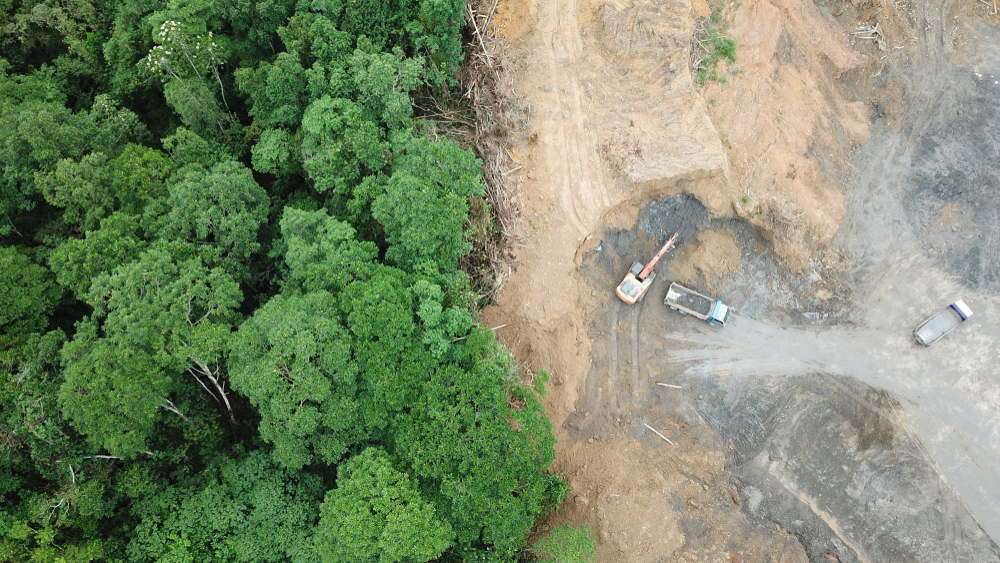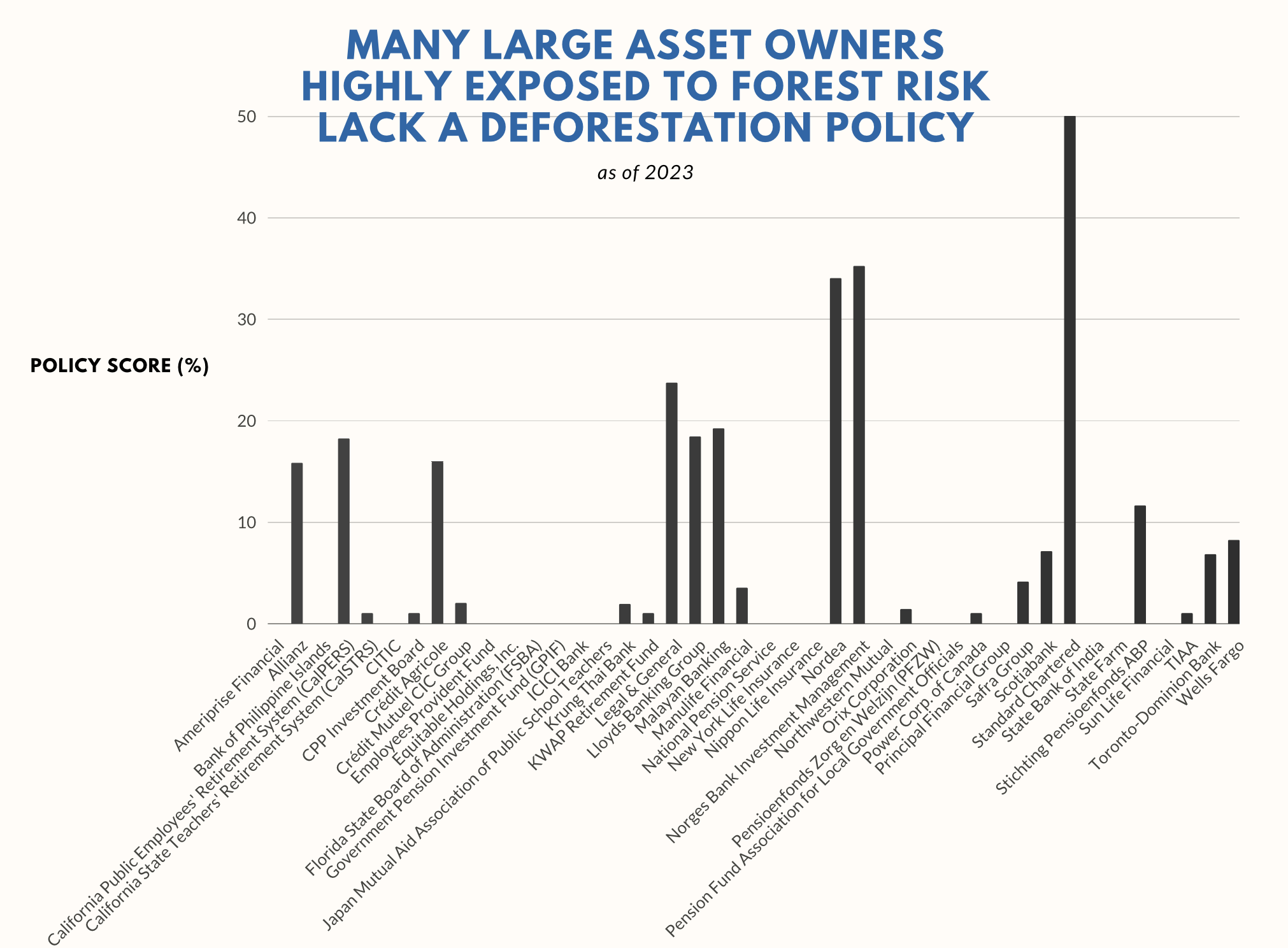
Most institutional investors still lack deforestation policy
The amount of capital flowing into deforestation dwarves positive investments, despite the key role forests play in tackling climate change
The private sector has not yet leveraged its significant power to steer development and commodity production onto a sustainable trajectory in line with forest goals, even though forests suck up one third of the world’s greenhouse gas emissions and are vital allies in the fight against climate change.
Almost two thirds of the 150 major financial players most exposed to deforestation do not yet have a single deforestation policy covering their forest-risk investment, according to WWF's Forest Pathways Report.
This leaves approximately $2.6 trillion in investments in high deforestation-risk commodities without appropriate safeguards, though this figure could be much higher.
In comparison, annual positive forest finance that aims to protect, restore and enhance forests is just $2.3 billion per year, a figure that needs to increase up to 200 times to meet 2030 goals.
Protecting forests is one of the few global, cross party, political aims and is enshrined in multiple international treaties, commitments, goals and targets including the 2021 Glasgow Leaders’ Declaration on Forests and Land Use (GLD) and the 2014 New York Declaration on Forests (NYDF).
Yet despite the many pledges and declarations, the WWF's Report finds that the world remains off track from the pathway to halting deforestation by 2030, with global deforestation in 2022 4% higher than in 2021.
Within the tropics, 4.1 million hectares of primary humid forest was lost in 2022, a 33% divergence from the 2022 target.
“We've had years of promises and targets from governments and corporates to end deforestation, but deforestation continues,” said Mike Barrett, executive director of science and conservation at WWF-UK. “And it's a catastrophe for the billions of people that rely on forests for their livelihoods, and for all of us who want to avoid runaway climate change.”
Barrett added that “we are kidding ourselves if we think that business as usual” is going to address the challenge.
Erin Matson, senior consultant at climate focus and coordinator for the Forest Declaration Assessment, said the "no-more-deforestation-by-2030" target, enshrined in both GLD and NYDF is not “just nice to have but essential for maintaining a liveable climate for humanity”.
Despite the importance of forests in tackling climate change, Matson said the topic is unlikely to feature strongly in the upcoming COP28.
Asset owners still lack clear policy
From a finance and investment perspective, one of the biggest problems is that very few institutional investors actually have an active deforestation policy.
That means there’s not even a “bare minimum effort” going into making deforestation considerations part of an investment decision.
Some sectors are more likely to be exposed to these kinds of risks and impacts, with the largest drivers of tropical deforestation including supply chains for beef, leather, soy, palm oil, timber, and pulp and paper.
“We are investing in activities that are harmful for forest at far higher rates than we are investing in activities that are beneficial for forests,” said Matson.
Poor transparency
The WWF doesn’t name individual asset owners and managers complicit in deforestation, because of “difficulties in tracking commodities”.
Take, for example, a commodity like soy whose various products are blended in “second stage systems and productions before they go out into the world”.
“Our regulatory systems still don’t require accountability for this opaque supply chain and production process, which is problematic,” said Dr Mary Gagen, chief advisor on forests at WWF-UK and author of the Forest Pathways Report. “The amount of granular data needed for these analyses makes it difficult.”
Despite the difficulties in measuring which asset owners and managers are most complicit in deforestation, the Forest 500 ranking system identifies the 350 companies with the greatest influence on tropical deforestation based on their exposure to deforestation risk, and the 150 financial institutions providing them with the greatest amount of finance.
It then scores the financial institution based on whether it holds an active deforestation policy and the strength of that policy, among other considerations.
Schroders is number one on their scoring system, with 50%, while the world’s largest asset manager, Blackrock, scores only 4%.
Many large pension funds score 0%. These include Japan’s Pension Fund Association for Local Government Officials, the Dutch Pensioenfonds Zorg en Welzijn (PFZW), Malaysia’s Employees Provident Fund, US Fidelity Investments, and South Korea’s National Pension Service.
Net Zero Investor filtered the data for asset owners and built the below graph.

Regulatory driven change?
Emma Thomson, Forest 500 and tracking lead at Global Canopy, said recent changes in legislation, such as the EU's Deforestation Regulation, has driven more and more financial institutions to look for guidance, data and tools they can use to ensure they are compliant.
For some this has led to publishing new deforestation policies, which is "a critical step" in any effective approach on deforestation as it publicly lays out their expectations, and should mean any new finance is compliant with the policy.
"But we haven’t yet had long enough to determine whether this means more financial institutions will publish new policies, especially given geographical limits of the existing legislation," said Thomson.
In the last ten years, Thomson has seen but a "small group" of emerging leaders make progress on deforestation, conversion, and associated human rights abuses
"Unfortunately, the majority of financial institutions have shown they are unwilling to act voluntarily on these issues, so we do still need legislation to cover financial institutions," she added.
Investments that contribute most to deforestation
The WWF looked at UK lending and investment to hundreds of producers, traders, processors and buyers of forest-risk commodities (cocoa, rubber, timber, soy, beef, palm oil, pulp & paper) from 2013 to 2021.
The non-profit found that the total investment over this period was £8.7 billion, primarily in revolving credit, underwriting and corporate loans.
The UK banking sector had well-established and largely consistent financial relationships with commodities traders over the timeframe.
The analysis also indicated sectoral concentration in a few large banks, asset managers, insurance and pension providers.
Most exposure was to palm oil (£2.1 billion), beef (£1.78 billion) and soy (£1.45 billion).
The level of UK investment in the same companies trading forest-risk commodities, especially palm oil and soy has remained largely consistent between 2015-2020, since the signing of the Paris Agreement.
The WWF also found that in the two years between 2016 and 2018, the UK’s demand for and trading of forest risk commodities required over 21 million hectares of overseas land.
“Effectively the UK is using an area nearly the size of the UK itself outside of its territories to produce commodities that may be putting forest at risks,” said Barrett.
This means that "importing countries like the UK need to be held more responsible" through stricter controls around the supply chains of imported goods".
Illegal forestry
The illegal forest sector is estimated to be worth $150 billion per year, globally, and undermines legitimate trade, according to the WWF report.
These significant illicit financial flows undermine global, regional and national initiatives to protect and support sustainable forest economies. Where illegality is associated with organized crime, it can also involve significant land- grabbing, land speculation, human rights abuses, corruption, and convergence with other crimes.
The WWF argues that addressing illegality is an important “enabling condition” to meet the positive forest pathways laid out in the report, because “good forest governance is necessary for the sustainable and equitable management of forests and land”.
Without rights establishment, and addressing corruption and illegality, transitions to sustainable economies can be undermined.
Overlaying supportive incentives, such as voluntary carbon finance, on structures such as illegality and poor governance risks unintended negative outcomes, the non-profit continues.
Forest crime is, at present, not prioritized evenly across nations so it remains a low-risk, high-reward sector undermining endeavours to establish green forest economies.
The WWF argues that forest crime needs to be viewed globally in the same bracket as serious organized crime, together with strengthened law enforcement and coordination between government departments, and consumer nations, to avoid undermining a just transition to sustainable and equitable forest economies.
Positive regulatory and policy developments
Despite the overall negative trend of continued deforestation, the WWF notes the emergence of some positive policies, and regulations, such as the EU Deforestation Regulation and Article 65 of the China Forest Law.
Trade agreements with producing countries which remove barriers and offer preferential trade to sustainable forest products are also a step forward.
The UK’s Environmental Act was set to introduce a due diligence regime for businesses trading in forest-risk commodities, but is not yet in force.
The UK Treasury is currently discussing whether to extend the due diligence regime to the finance sector and has held roundtable discussions with stakeholders.
The WWF argues that the fact that the Treasury and the Financial Conduct Authority and others are already actively thinking about extending the due diligence regime to the financial sector is a positive sign.
Other positive policy developments include regional, medium-term solutions, such as Project Finance for Permanence, payments for ecosystem services, moratoria on expanding commodity crops in forests, and log export bans.
Some countries have managed to buck the trend. Based on WWF's 2022 data, over 50 countries are on track to end deforestation within their borders by 2030.
For example, both Indonesia and Malaysia have sustained their recent deforestation reductions in 2022. Their success has contributed to tropical Asia being the only tropical region that is nearly on track to meet the 2030 goal.
“Of course, in a globalised world, we can't look at these countries’ success in a vacuum,” said Matson. “But their formula is beginning to work.”
Matson attributed much of the success to “strong laws, strong enforcement, collaboration amongst the private sector, civil society and governments, strong support and recognition of the rights of indigenous peoples and local communities, as well as sheer political will”.
Matson also noted positive developments in Brazil under the Lula administration.
“If we're going to halt deforestation and forest degradation, we need to see huge political will demonstrated by governments,” said Darragh Conway, lead legal consultant at Climate Focus and lead on rights & governance for the Forest Declaration Assessment.
That political will then “needs to be translated into clear and effective laws and policies, governance systems that protect forests, all of which should be implemented consistently and fairly and transparently”.
Regarding innovative financial instruments, the WWF argues that blended finance schemes, debt-for-nature swaps, growing and allocating direct finance to Indigenous Peoples and local communities, and removing market distortions from the harmful allocation of subsidies and finance can all support a just transition to sustainable forest economies.




